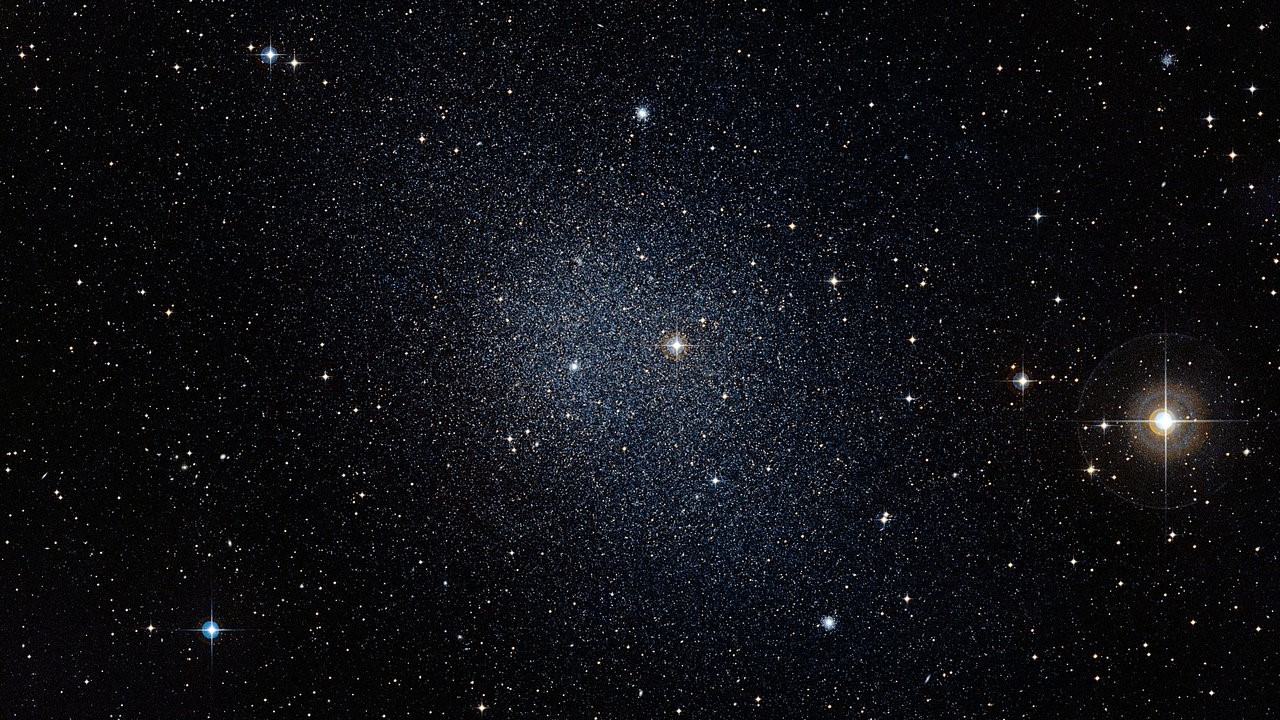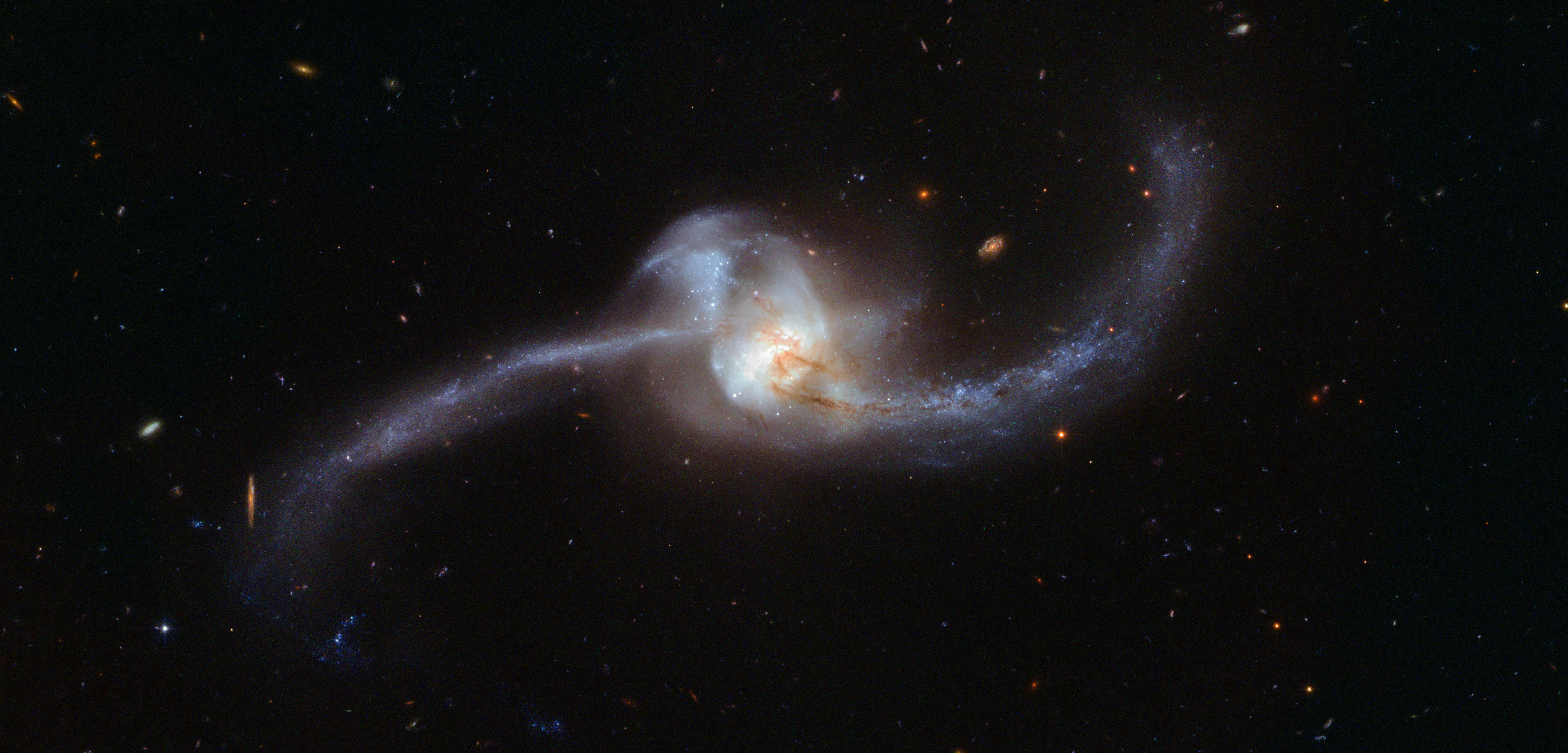Strange arrangement of Milky Way's groupie galaxies may undermine dark matter
Has one of the biggest challenges to the theory of cold dark matter finally been removed?

Scientists may have explained the mysterious distribution of small satellite galaxies around our Milky Way that has long puzzled astronomers, but not everyone is in agreement.
The Milky Way galaxy is surrounded by smaller dwarf galaxies. The conventional model of galaxy growth proposes that these small galaxies were trapped by a massive halo of dark matter, material that scientists can't see but that appears to shape the universe. The dwarf galaxies then came together to form larger galaxies, and the dwarfs that we see today are the leftovers of that process, the theory goes. However, if this is the case then astronomers would expect the surviving dwarf galaxies to be scattered randomly around the Milky Way's dark matter halo. Instead, they seem to be confined to a single plane that cuts through our galaxy at an angle, an oddity that threatens our understanding of the dark matter–dominated universe.
Now, astronomers led by Till Sawalha of the University of Helsinki in Finland have offered an explanation. Using measurements from the European Space Agency's Gaia mission of how the satellite galaxies are moving across the sky, they calculated the trajectories of the satellite galaxies forward and backward in time. In doing so, they revealed that the satellite galaxies were not aligned in the past and won't be in the future — instead, the plane that they are in now is just a chance, temporary arrangement.
"If you look at the velocities of the satellite galaxies today, they are moving along the plane, but what we did that's really new and exciting is forecast where their orbits are taking them in a billion years time," Carlos Frenk, a cosmologist at the University of Durham in the U.K. and a member of Sawalha's team, told Space.com. "They just happen to be in the plane today, that's the coincidence of the whole thing, and in a billion years or less they will leave the plane."
Related: Milky Way's seasonal transition captured in gorgeous night sky photo
Although it seems as though the odds of us being around at the same time as the satellite galaxies are all lined up in the same plane are slim, coincidences do happen. For example, Saturn's rings are young, and the fact that we exist at the same time as the rings is a coincidence. Another unlikely occurrence is the ability of Earth's moon to block the sun just precisely enough to cause a total solar eclipse; since the moon is moving slowly away from Earth, in the future it will be too small in the sky to block the sun totally. Yet, we are coincidentally here to see the spectacle of totality.
However, this line of argument does not win over everyone. Marcel Pawlowski, an astronomer at the Leibniz Institute for Astrophysics in Germany who did not take part in the research, is skeptical about the coincidence of a chance alignment. "Why would we be here at this special time right now when the satellite galaxies have this distribution?" he told Space.com. "There's no real reason for that."
Breaking space news, the latest updates on rocket launches, skywatching events and more!
The existence of the plane of satellites is also an important prediction of Modified Newtonian Dynamics, or MOND, which is a rival to the theory of dark matter. Astronomers came up with dark matter to explain galaxies that stay together even though their gravity appears too low to maintain them. MOND says instead that dark matter does not exist, and what we see as extra gravity is caused by a tweak to Newtonian gravity at low accelerations, such as those of stars orbiting galaxies or satellite galaxies orbiting the Milky Way.
According to MOND, "the Milky Way and the Andromeda galaxy should have had a past encounter about 8 billion years ago," Pawlowski said. In this scenario, the gravity of the Andromeda galaxy should have ripped material from the Milky Way, creating what astronomers call a tidal tail, like we see in the interactions of other galaxies. The gas and stars in this tidal tail could have coalesced into a bunch of dwarf galaxies lined up with the trajectory of the Milky Way coming from its encounter with the Andromeda galaxy, MOND argues. If true, the same process should have formed a plane of satellite galaxies around the Andromeda galaxy as well as the Milky Way's.
It turns out that the Andromeda galaxy does have a plane of satellites, as do several other nearby galaxies, including Centaurus A, which is still reeling from a galaxy interaction and merger that it experienced about 2 billion years ago.
However, Frenk said he disagrees with the MOND explanation for the Milky Way's companions. "After we found the plane of satellites around the Milky Way, people went looking for planes around other galaxies and defined them using completely different criteria," he said. "You really have to work hard and include some of the satellites but throw some others out to define this structure, but even when you take that into account, the plane of satellites around the Andromeda galaxy is commonplace in simulations of galaxies with cold dark matter."
While simulations are all well and good, observational data is key. Gaia is our most sensitive instrument for measuring the positions and proper motions of stars and galaxies through space.
"Gaia data is pretty good — it's revolutionary — but it still has some uncertainties," Pawlowski said. Previously he had measured the proper motions of the satellite galaxies with not only Gaia's data, but also measurements from the Hubble Space Telescope for an even more precise assessment. "For some reason [the Hubble measurements] have been largely ignored in this study," Pawlowski lamented.
Could the Gaia uncertainties really be enough to lead to an incorrect conclusion? Pawlowski draws an analogy to a bunch of marbles all rolling in a perfect line, all in the same direction with no tangential speed away from their path. If you measure the motion of the marbles, but you have even a small amount of uncertainty in the accuracy of your measurement of their tangential velocity away from the line, and you then project your measurements and their uncertainties forward in time, you will erroneously predict that the marbles will disperse over time.
The theory of cold dark matter is still the clear frontrunner overall. There is more evidence for it, although MOND supporters would say that is not surprising given the difference in the amount of funding spent on dark-matter research compared to MOND. On the other hand, MOND has had a few wins, such as predicting the acceleration measured in galaxy rotation curves.
Nevertheless, dark matter theorists are ultimately happy with this new result.
"We have been able to remove one of the main outstanding challenged to the cold dark matter theory," Frenk said in a statement. "It continues to provide a remarkably faithful description of the evolution of our universe."
The research is described in a paper published Monday (Dec. 19) in the journal Nature Astronomy.
Follow Keith Cooper on Twitter @21stCenturySETI. Follow us on Twitter @Spacedotcom and on Facebook.

Keith Cooper is a freelance science journalist and editor in the United Kingdom, and has a degree in physics and astrophysics from the University of Manchester. He's the author of "The Contact Paradox: Challenging Our Assumptions in the Search for Extraterrestrial Intelligence" (Bloomsbury Sigma, 2020) and has written articles on astronomy, space, physics and astrobiology for a multitude of magazines and websites.

